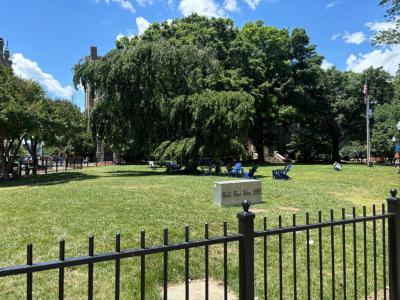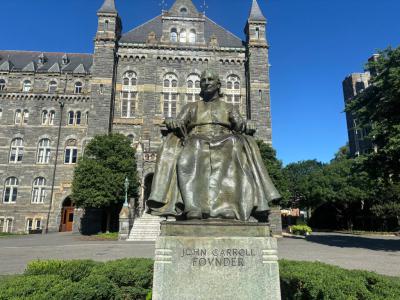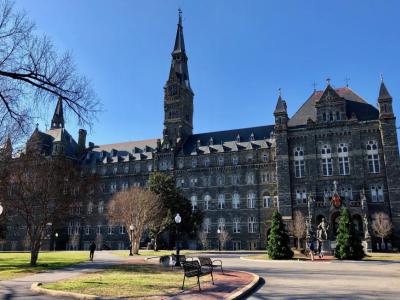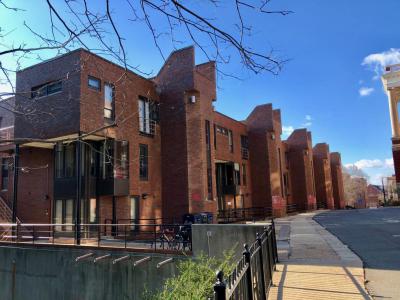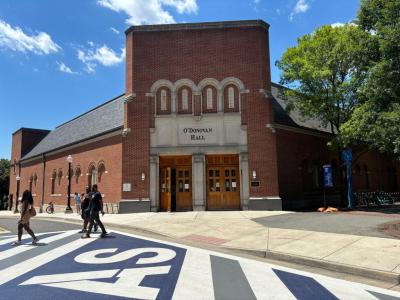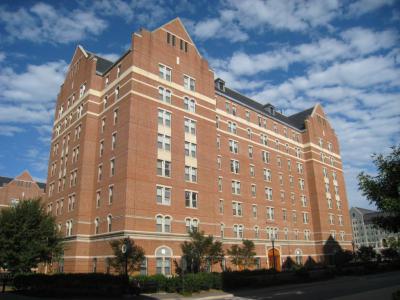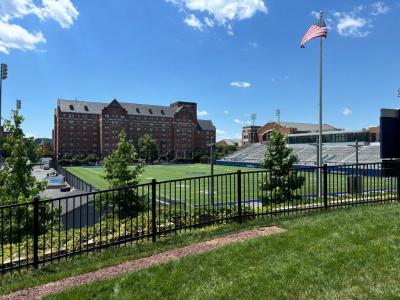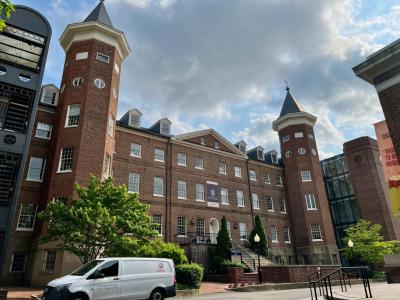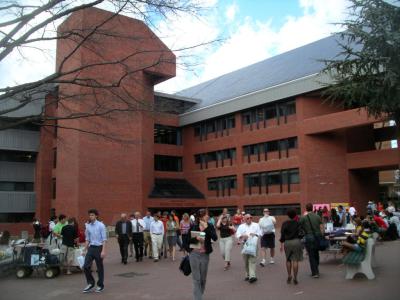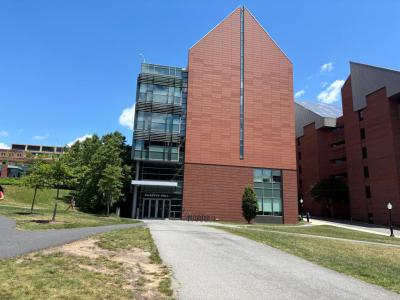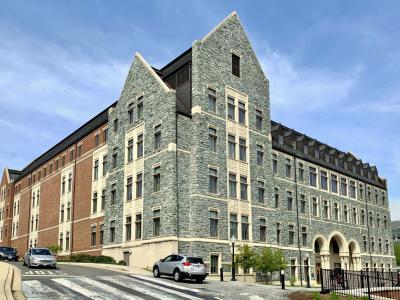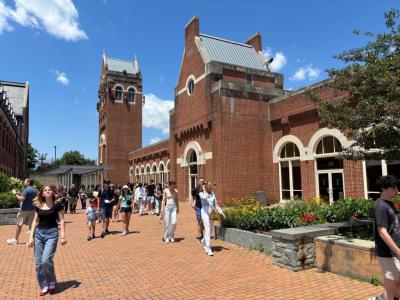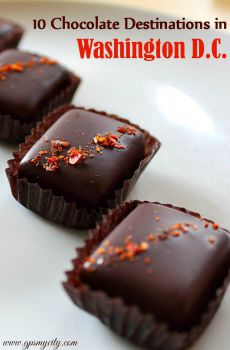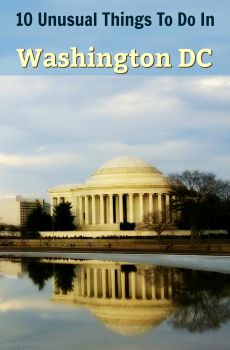
Georgetown University Walking Tour (Self Guided), Washington D.C.
Georgetown University, established in 1789, is America's oldest Catholic and Jesuit institution. Spanning four campuses in Washington, DC, its main undergraduate campus in Georgetown features fifty-four buildings across 104 acres.
With its Gothic and Georgian architecture, serene green spaces, and Jesuit traditions, the university promotes academic excellence and global engagement. For those unfamiliar with its iconic landmarks, here’s a glimpse into its campus.
White-Gravenor Hall houses classrooms and administrative offices where students engage in rigorous learning. Nearby, Copley Hall offers a blend of dormitory living and academic spaces, fostering a vibrant community atmosphere. Adjacent to Copley Hall is the picturesque Copley Lawn, a popular gathering spot for students to relax or study outdoors.
A focal point on campus is the Archbishop John Carroll Statue, honoring the university's founder. Healy Hall, with its grand architecture and clock tower designed by architects of the Library of Congress, is a National Historic Landmark and the university’s main building, hosting classrooms, offices, and a rich history within its walls.
Lauinger Library, a hub of research and study, supports students with extensive collections and modern facilities. Meanwhile, Village A offers residential housing with a sense of community, complemented by Leo O’Donovan Dining Hall, where students gather for meals and socializing.
McCarthy Hall provides additional housing options, while Cooper Field serves as a venue for sports and outdoor activities. The serene Dahlgren Chapel offers a place for spiritual reflection and community worship.
Other locations like the Old North Building and the Edward B Bunn, SJ Intercultural Center provide additional academic spaces, fostering diverse learning environments. Regents Hall and the Rafik B Hariri Building house specialized academic departments and administrative offices.
Finally, the Leavey Center serves as a hub of student life, featuring dining options, student organizations, and recreational facilities.
Indeed, Georgetown University is a blend of academic rigor with a rich history and vibrant campus life, providing a stimulating environment for learning and personal growth. Whether exploring its historic buildings, engaging in scholarly pursuits, or enjoying campus events, a visit here is a unique and enriching university experience.
With its Gothic and Georgian architecture, serene green spaces, and Jesuit traditions, the university promotes academic excellence and global engagement. For those unfamiliar with its iconic landmarks, here’s a glimpse into its campus.
White-Gravenor Hall houses classrooms and administrative offices where students engage in rigorous learning. Nearby, Copley Hall offers a blend of dormitory living and academic spaces, fostering a vibrant community atmosphere. Adjacent to Copley Hall is the picturesque Copley Lawn, a popular gathering spot for students to relax or study outdoors.
A focal point on campus is the Archbishop John Carroll Statue, honoring the university's founder. Healy Hall, with its grand architecture and clock tower designed by architects of the Library of Congress, is a National Historic Landmark and the university’s main building, hosting classrooms, offices, and a rich history within its walls.
Lauinger Library, a hub of research and study, supports students with extensive collections and modern facilities. Meanwhile, Village A offers residential housing with a sense of community, complemented by Leo O’Donovan Dining Hall, where students gather for meals and socializing.
McCarthy Hall provides additional housing options, while Cooper Field serves as a venue for sports and outdoor activities. The serene Dahlgren Chapel offers a place for spiritual reflection and community worship.
Other locations like the Old North Building and the Edward B Bunn, SJ Intercultural Center provide additional academic spaces, fostering diverse learning environments. Regents Hall and the Rafik B Hariri Building house specialized academic departments and administrative offices.
Finally, the Leavey Center serves as a hub of student life, featuring dining options, student organizations, and recreational facilities.
Indeed, Georgetown University is a blend of academic rigor with a rich history and vibrant campus life, providing a stimulating environment for learning and personal growth. Whether exploring its historic buildings, engaging in scholarly pursuits, or enjoying campus events, a visit here is a unique and enriching university experience.
How it works: Download the app "GPSmyCity: Walks in 1K+ Cities" from Apple App Store or Google Play Store to your mobile phone or tablet. The app turns your mobile device into a personal tour guide and its built-in GPS navigation functions guide you from one tour stop to next. The app works offline, so no data plan is needed when traveling abroad.
Georgetown University Walking Tour Map
Guide Name: Georgetown University Walking Tour
Guide Location: USA » Washington D.C. (See other walking tours in Washington D.C.)
Guide Type: Self-guided Walking Tour (Sightseeing)
# of Attractions: 16
Tour Duration: 2 Hour(s)
Travel Distance: 2.1 Km or 1.3 Miles
Author: irene
Sight(s) Featured in This Guide:
Guide Location: USA » Washington D.C. (See other walking tours in Washington D.C.)
Guide Type: Self-guided Walking Tour (Sightseeing)
# of Attractions: 16
Tour Duration: 2 Hour(s)
Travel Distance: 2.1 Km or 1.3 Miles
Author: irene
Sight(s) Featured in This Guide:
- White-Gravenor Hall
- Copley Hall
- Copley Lawn
- Archbishop John Carroll Statue
- Healy Hall
- Lauinger Library
- Village A
- Leo O’Donovan Dining Hall
- McCarthy Hall
- Cooper Field
- Dahlgren Chapel
- Old North Building
- Edward B. Bunn, S.J. Intercultural Center
- Regents Hall
- Rafik B. Hariri Building
- Leavey Center
1) White-Gravenor Hall
White-Gravenor Hall, completed in 1933, is a notable building on the Georgetown University campus. This building serves as a hub for several key administrative offices, including the Office of Undergraduate Admissions, the Office of the Registrar, and the Dean’s Office of Georgetown College. Originally constructed as a Science-Recitation hall, White-Gravenor Hall has since evolved to play a central role in the academic and administrative life of the university.
Named in honor of two early Jesuit missionaries, Andrew White and John Altham alias Gravenor, who arrived in Maryland in 1634, White-Gravenor Hall embodies the rich Catholic and Jesuit heritage of Georgetown University. Its architecture is laden with symbolic details, earning it the description of a "sermon in stone." The external facade is adorned with intricate carvings that reflect various academic subjects, each accompanied by the name of a prominent Jesuit educator in that field. For instance, the name Suarez, paired with the lamp of learning, represents Philosophy, while Kircher, associated with scientific instruments, symbolizes Science.
One of the most striking features of White-Gravenor Hall is the three-story oriel over the main entrance, which includes these carved symbols of academic disciplines. Directly above the door, five shields represent academies founded by the Jesuits in Maryland, further emphasizing the building's deep connection to Jesuit educational traditions. These architectural elements not only enhance the aesthetic appeal of the building but also serve as a testament to the Jesuit commitment to education and intellectual pursuit.
Named in honor of two early Jesuit missionaries, Andrew White and John Altham alias Gravenor, who arrived in Maryland in 1634, White-Gravenor Hall embodies the rich Catholic and Jesuit heritage of Georgetown University. Its architecture is laden with symbolic details, earning it the description of a "sermon in stone." The external facade is adorned with intricate carvings that reflect various academic subjects, each accompanied by the name of a prominent Jesuit educator in that field. For instance, the name Suarez, paired with the lamp of learning, represents Philosophy, while Kircher, associated with scientific instruments, symbolizes Science.
One of the most striking features of White-Gravenor Hall is the three-story oriel over the main entrance, which includes these carved symbols of academic disciplines. Directly above the door, five shields represent academies founded by the Jesuits in Maryland, further emphasizing the building's deep connection to Jesuit educational traditions. These architectural elements not only enhance the aesthetic appeal of the building but also serve as a testament to the Jesuit commitment to education and intellectual pursuit.
2) Copley Hall
Copley Hall, one of Georgetown University's oldest dormitories, was built in 1932 and serves as an underclassmen residence hall. This neo-gothic stone building, named for Thomas Copley S.J., stands prominently next to Healy Hall and across from the front gates of the university. Its central location on the main campus makes it a pivotal part of student life at Georgetown. The residence hall features suite-style apartments, consisting of double occupancy rooms with shared bathrooms between two rooms, which provide a comfortable living environment for students. Additionally, Copley Hall accommodates physically disabled students and offers rooms for members of Georgetown's basketball team.
The first floor of Copley Hall houses the Copley Formal Lounge, a reception space used for student and university gatherings, enhancing the sense of community within the hall. Copley Hall is also home to the Global Living Experience and the French Floor, specialized living communities that foster cultural exchange and language immersion among residents. These unique living arrangements contribute to the diverse and vibrant atmosphere of Copley Hall.
Copley Hall is notable for its religious spaces, catering to the spiritual needs of Georgetown's diverse student body. The Copley Crypt, located in the basement, serves Eastern Orthodox Vesper Services, while St. William's Chapel, situated above it on the first floor, offers a serene space for Catholic worship. Additionally, the building includes a Muslim Prayer Room and a Dharmalaya, dedicated to all Dharmic religions, which opened in Spring 2020. These facilities underscore Georgetown's commitment to providing inclusive and supportive environments for students of all faiths.
Copley Hall's picturesque location in front of Copley Lawn, a popular site for outdoor events, further enhances its appeal. The combination of historical significance, comfortable living arrangements, specialized communities, and diverse worship spaces makes Copley Hall a cherished and integral part of Georgetown University.
The first floor of Copley Hall houses the Copley Formal Lounge, a reception space used for student and university gatherings, enhancing the sense of community within the hall. Copley Hall is also home to the Global Living Experience and the French Floor, specialized living communities that foster cultural exchange and language immersion among residents. These unique living arrangements contribute to the diverse and vibrant atmosphere of Copley Hall.
Copley Hall is notable for its religious spaces, catering to the spiritual needs of Georgetown's diverse student body. The Copley Crypt, located in the basement, serves Eastern Orthodox Vesper Services, while St. William's Chapel, situated above it on the first floor, offers a serene space for Catholic worship. Additionally, the building includes a Muslim Prayer Room and a Dharmalaya, dedicated to all Dharmic religions, which opened in Spring 2020. These facilities underscore Georgetown's commitment to providing inclusive and supportive environments for students of all faiths.
Copley Hall's picturesque location in front of Copley Lawn, a popular site for outdoor events, further enhances its appeal. The combination of historical significance, comfortable living arrangements, specialized communities, and diverse worship spaces makes Copley Hall a cherished and integral part of Georgetown University.
3) Copley Lawn
Copley Lawn is one of the largest and most cherished open green spaces on Georgetown University's campus. These expansive lawns provide an inviting environment for students to read, relax, and engage in recreational sports, especially during pleasant weather. The lawns are a vital part of campus life, fostering a sense of community and offering a scenic retreat amidst the academic bustle.
Historically, Copley Lawn has been central to Georgetown's athletic life. Until 1928, it served as the university's football and baseball fields, hosting numerous games and events that were integral to the campus's sporting culture. The transformation of this area into a lush green space reflects the university's evolving needs and its commitment to creating a harmonious and aesthetically pleasing environment for its students.
The stone wall bordering Copley Lawn marks the official boundary of Georgetown's main campus. However, the university's reach extends beyond this wall, encompassing an additional three blocks into the surrounding Georgetown neighborhood. This extension includes Poulton Hall, which stands just across the stone wall. Poulton Hall is home to the Center for Social Justice, underscoring Georgetown's dedication to community engagement and service. It also houses Mask & Bauble, a student-led theater organization that highlights the vibrant cultural and artistic life at Georgetown.
Historically, Copley Lawn has been central to Georgetown's athletic life. Until 1928, it served as the university's football and baseball fields, hosting numerous games and events that were integral to the campus's sporting culture. The transformation of this area into a lush green space reflects the university's evolving needs and its commitment to creating a harmonious and aesthetically pleasing environment for its students.
The stone wall bordering Copley Lawn marks the official boundary of Georgetown's main campus. However, the university's reach extends beyond this wall, encompassing an additional three blocks into the surrounding Georgetown neighborhood. This extension includes Poulton Hall, which stands just across the stone wall. Poulton Hall is home to the Center for Social Justice, underscoring Georgetown's dedication to community engagement and service. It also houses Mask & Bauble, a student-led theater organization that highlights the vibrant cultural and artistic life at Georgetown.
4) Archbishop John Carroll Statue
The statue of Archbishop John Carroll, located on the Georgetown University campus, stands as a tribute to the founder of the institution and the first Catholic bishop in the United States. Created by Irish sculptor Jerome Connor, the bronze sculpture depicts Carroll seated in a chair, gazing thoughtfully towards the front gates of the university and the Potomac River beyond. His right hand holds a book, symbolizing his dedication to education and knowledge, with his index finger marking a page.
The design of the statue, with its detailed depiction of Carroll and the inclusion of a stack of books beneath his chair, draws inspiration from the John Harvard statue at Harvard University. Dressed in Jesuit ecclesiastical attire, Carroll's serene and contemplative expression reflects his pivotal role in establishing Georgetown University with the support of a grant from George Washington.
Behind the statue of Archbishop Carroll is Healy Hall, an iconic building named after Patrick Healy, S.J., the first African American president of a non-historically black college or university.
Unveiled in 1912 during an elaborate three-day ceremony, the statue has since become an integral part of Georgetown University's landscape. The unveiling event attracted thousands of attendees, including high-ranking clergy, members of Congress, judges, and distinguished alumni. Positioned on a circular lawn known as Healy Circle, the statue not only commemorates Carroll's legacy but also serves as a focal point for student life and campus traditions. Over the years, students have engaged in various lighthearted activities involving the statue, including the enduring tradition of sitting in the archbishop's lap.
The design of the statue, with its detailed depiction of Carroll and the inclusion of a stack of books beneath his chair, draws inspiration from the John Harvard statue at Harvard University. Dressed in Jesuit ecclesiastical attire, Carroll's serene and contemplative expression reflects his pivotal role in establishing Georgetown University with the support of a grant from George Washington.
Behind the statue of Archbishop Carroll is Healy Hall, an iconic building named after Patrick Healy, S.J., the first African American president of a non-historically black college or university.
Unveiled in 1912 during an elaborate three-day ceremony, the statue has since become an integral part of Georgetown University's landscape. The unveiling event attracted thousands of attendees, including high-ranking clergy, members of Congress, judges, and distinguished alumni. Positioned on a circular lawn known as Healy Circle, the statue not only commemorates Carroll's legacy but also serves as a focal point for student life and campus traditions. Over the years, students have engaged in various lighthearted activities involving the statue, including the enduring tradition of sitting in the archbishop's lap.
5) Healy Hall
Healy Hall, a National Historic Landmark, is the flagship building of Georgetown University's main campus. Constructed between 1877 and 1879, it was designed by architects Paul J. Pelz and John L. Smithmeyer, who also designed the Thomas Jefferson Building of the Library of Congress. The hall is named after Patrick Francis Healy, the president of Georgetown University during its construction. Known for its Neo-Romanesque and High Victorian Gothic architecture, Healy Hall stands as one of the last large-scale examples of this style in the United States.
The building serves as the primary administrative and reception venue for the university, while also housing classrooms and important university offices. Notably, Healy Hall contains Riggs Library, one of the few remaining cast iron libraries in the nation, and Gaston Hall, a grand auditorium often referred to as Georgetown's "Jewel in the Crown." The architecture of Healy Hall is a blend of Romanesque, Early Gothic, Late Gothic, and Early Renaissance styles, creating a unique and historic aesthetic that reflects the university's rich heritage.
Healy Hall is home to several key departments and institutes, including the Office of the President, Georgetown's Department of Classics, the Kennedy Institute of Ethics, and the Bioethics Research Library. Its notable rooms include the Philodemic Room, the meeting space for one of the oldest collegiate debating clubs in the nation; the Hall of Cardinals; the historic Constitution Room; and the Carroll Parlor, which features several significant pieces from the university's art collection. Each of these spaces contributes to the building's role as a center for academic and administrative activities at Georgetown.
Perhaps the most distinguished feature of Healy Hall is Gaston Hall, a 750-seat auditorium located on the third and fourth floors. Named after William Gaston, Georgetown's first student, this auditorium is adorned with the coats of arms of Jesuit colleges and universities, as well as rich allegorical scenes painted by Jesuit artist Brother Francis C. Schroen. Gaston Hall has hosted numerous world leaders and remains a symbol of Georgetown University's commitment to fostering dialogue and learning on a global scale.
The building serves as the primary administrative and reception venue for the university, while also housing classrooms and important university offices. Notably, Healy Hall contains Riggs Library, one of the few remaining cast iron libraries in the nation, and Gaston Hall, a grand auditorium often referred to as Georgetown's "Jewel in the Crown." The architecture of Healy Hall is a blend of Romanesque, Early Gothic, Late Gothic, and Early Renaissance styles, creating a unique and historic aesthetic that reflects the university's rich heritage.
Healy Hall is home to several key departments and institutes, including the Office of the President, Georgetown's Department of Classics, the Kennedy Institute of Ethics, and the Bioethics Research Library. Its notable rooms include the Philodemic Room, the meeting space for one of the oldest collegiate debating clubs in the nation; the Hall of Cardinals; the historic Constitution Room; and the Carroll Parlor, which features several significant pieces from the university's art collection. Each of these spaces contributes to the building's role as a center for academic and administrative activities at Georgetown.
Perhaps the most distinguished feature of Healy Hall is Gaston Hall, a 750-seat auditorium located on the third and fourth floors. Named after William Gaston, Georgetown's first student, this auditorium is adorned with the coats of arms of Jesuit colleges and universities, as well as rich allegorical scenes painted by Jesuit artist Brother Francis C. Schroen. Gaston Hall has hosted numerous world leaders and remains a symbol of Georgetown University's commitment to fostering dialogue and learning on a global scale.
6) Lauinger Library
The Joseph Mark Lauinger Library, colloquially known as "Lau" among Georgetown students, stands as the main library of Georgetown University and the central hub of its extensive seven-library system, boasting a collection of 3.5 million volumes. Opened on April 6, 1970, the library was named in honor of Joseph Mark Lauinger, an alumnus and chime of Georgetown who lost his life in the Vietnam War. It houses a vast array of resources, including 1.7 million volumes spread across six floors, offering ample space for both individual and group study.
Designed by architect John Carl Warnecke, Lauinger Library embodies brutalist architecture and serves as a modern interpretation of the nearby Healy Hall, a Flemish Romanesque landmark on campus. Its striking design features iconic spires that echo the clock tower of Healy, creating a visually impressive structure that overlooks panoramic views of the Potomac River and the skyline of neighboring Rosslyn, Virginia.
The library is not only a space for academic pursuits but also a cultural hub, hosting the Booth Center for Special Collections on its fifth floor, named after David G. Booth. This center houses an extensive collection of rare books, manuscripts, art, and archival documents related to Georgetown University, enriching the academic experience of students and scholars alike.
In addition to its scholarly resources, Lauinger Library is home to "The Midnight MUG," a popular coffee shop operated by The Students of Georgetown, Inc., commonly known as "The Corp." Since its inception in 2003, Midnight MUG has provided students with a cozy space to socialize, recharge, and fuel their studies with caffeine, further enhancing the vibrant atmosphere of the library as a hub of student life and academic excellence.
Designed by architect John Carl Warnecke, Lauinger Library embodies brutalist architecture and serves as a modern interpretation of the nearby Healy Hall, a Flemish Romanesque landmark on campus. Its striking design features iconic spires that echo the clock tower of Healy, creating a visually impressive structure that overlooks panoramic views of the Potomac River and the skyline of neighboring Rosslyn, Virginia.
The library is not only a space for academic pursuits but also a cultural hub, hosting the Booth Center for Special Collections on its fifth floor, named after David G. Booth. This center houses an extensive collection of rare books, manuscripts, art, and archival documents related to Georgetown University, enriching the academic experience of students and scholars alike.
In addition to its scholarly resources, Lauinger Library is home to "The Midnight MUG," a popular coffee shop operated by The Students of Georgetown, Inc., commonly known as "The Corp." Since its inception in 2003, Midnight MUG has provided students with a cozy space to socialize, recharge, and fuel their studies with caffeine, further enhancing the vibrant atmosphere of the library as a hub of student life and academic excellence.
7) Village A
Village A stands as an upperclassmen apartment complex within Georgetown University's campus, offering housing for students in comfortable apartment-style accommodations. Each apartment within Village A is designed to accommodate four students, featuring two bedrooms, a living room, kitchen, and bathroom. One of the highlights of Village A is its spectacular views, which can be enjoyed by climbing the numerous sets of stairs within the complex. From these vantage points, students can marvel at the breathtaking sights of downtown Washington, DC, and the majestic Potomac River, providing a scenic backdrop to their university experience.
For those seeking accessibility options, Village A provides an ADA route that bypasses the need to climb stairs. Instead, students can continue past the apartment complex until they reach a gap on the left, leading to the Student Center. Upon entering the gap, an elevator on the left provides access to the top floor, where students can step out onto the Village A rooftop.
Village A not only offers comfortable living spaces but also serves as a vibrant hub of student life within the Georgetown campus. Its convenient location, combined with its cozy apartments and stunning views, makes it a sought-after residence for upperclassmen seeking a well-rounded university experience. Additionally, its proximity to the Healey Family Student Center allows residents easy access to various campus facilities, further enhancing the convenience and appeal of Village A as a desirable housing option for Georgetown students.
For those seeking accessibility options, Village A provides an ADA route that bypasses the need to climb stairs. Instead, students can continue past the apartment complex until they reach a gap on the left, leading to the Student Center. Upon entering the gap, an elevator on the left provides access to the top floor, where students can step out onto the Village A rooftop.
Village A not only offers comfortable living spaces but also serves as a vibrant hub of student life within the Georgetown campus. Its convenient location, combined with its cozy apartments and stunning views, makes it a sought-after residence for upperclassmen seeking a well-rounded university experience. Additionally, its proximity to the Healey Family Student Center allows residents easy access to various campus facilities, further enhancing the convenience and appeal of Village A as a desirable housing option for Georgetown students.
8) Leo O’Donovan Dining Hall
Leo O'Donovan Dining Hall, affectionately known as Leo O'Donovan Dining Hall, is a bustling dining complex. With a capacity to accommodate 625 people per floor, this two-story dining facility provides an expansive space for students to dine, socialize, and enjoy a variety of culinary offerings. The hall boasts a diverse selection of fresh, authentic global cuisine, catering to the diverse tastes and preferences of the university community.
At the heart of O'Donovan Hall is LEO|MKT, located on the top floor of the complex. LEO|MKT serves as a vibrant marketplace, offering an array of culinary options from seven different food stations. Whether students crave international flavors, savory classics, or innovative dishes, they can find a satisfying meal to suit their appetite at LEO|MKT. The marketplace concept provides a dynamic dining experience, allowing students to explore and indulge in a diverse range of culinary delights.
Descending the stairs from LEO|MKT leads students to the buffet-style dining experience operated by the Fresh Food Co. Here, students can enjoy a feast of freshly prepared meals, featuring exhibition cooking and made-to-order dishes. With an emphasis on freshness, quality, and healthfulness, the Fresh Food Co. offers students a convenient and nutritious dining option that caters to their dietary needs and preferences.
Overall, O'Donovan Hall serves as a vibrant epicenter of campus dining, providing students with a welcoming environment to nourish their bodies and connect with their peers.
At the heart of O'Donovan Hall is LEO|MKT, located on the top floor of the complex. LEO|MKT serves as a vibrant marketplace, offering an array of culinary options from seven different food stations. Whether students crave international flavors, savory classics, or innovative dishes, they can find a satisfying meal to suit their appetite at LEO|MKT. The marketplace concept provides a dynamic dining experience, allowing students to explore and indulge in a diverse range of culinary delights.
Descending the stairs from LEO|MKT leads students to the buffet-style dining experience operated by the Fresh Food Co. Here, students can enjoy a feast of freshly prepared meals, featuring exhibition cooking and made-to-order dishes. With an emphasis on freshness, quality, and healthfulness, the Fresh Food Co. offers students a convenient and nutritious dining option that caters to their dietary needs and preferences.
Overall, O'Donovan Hall serves as a vibrant epicenter of campus dining, providing students with a welcoming environment to nourish their bodies and connect with their peers.
9) McCarthy Hall
McCarthy Hall stands as an integral part of a trio of residence halls, along with Kennedy and Reynolds, collectively forming the Southwest Quad at Georgetown University. Together, these halls provide accommodation for approximately 780 students, fostering a vibrant and inclusive residential community. McCarthy Hall, nestled within this complex, offers a dynamic living environment that encourages social interaction, academic collaboration, and personal growth among its residents.
Each floor of McCarthy Hall features a communal space equipped with a full kitchen, providing residents with opportunities to engage in shared meals, social gatherings, and collaborative study sessions. This communal setting serves as a hub where students can forge friendships, exchange ideas, and cultivate a sense of belonging within the larger university community. Whether bonding over a home-cooked meal, catching up on favorite TV shows, or collaborating on group projects, residents of McCarthy Hall benefit from a supportive and inclusive living environment that enriches their college experience.
McCarthy Hall is also home to distinctive living learning communities, including the Transfer Living Learning Community and the Justice & Diversity in Action Living Learning Community. These specialized communities offer unique opportunities for students to connect with peers who share similar interests, backgrounds, and aspirations. As part of the Southwest Quad, McCarthy Hall plays a vital role in fostering a sense of community, belonging, and academic excellence among its diverse student population.
Each floor of McCarthy Hall features a communal space equipped with a full kitchen, providing residents with opportunities to engage in shared meals, social gatherings, and collaborative study sessions. This communal setting serves as a hub where students can forge friendships, exchange ideas, and cultivate a sense of belonging within the larger university community. Whether bonding over a home-cooked meal, catching up on favorite TV shows, or collaborating on group projects, residents of McCarthy Hall benefit from a supportive and inclusive living environment that enriches their college experience.
McCarthy Hall is also home to distinctive living learning communities, including the Transfer Living Learning Community and the Justice & Diversity in Action Living Learning Community. These specialized communities offer unique opportunities for students to connect with peers who share similar interests, backgrounds, and aspirations. As part of the Southwest Quad, McCarthy Hall plays a vital role in fostering a sense of community, belonging, and academic excellence among its diverse student population.
10) Cooper Field
Cooper Field is a versatile multi-purpose stadium with a seating capacity of 4,418. Originally known as Harbin Field, it was primarily used for intramural sports before being adapted for soccer in 1994. The field underwent several name changes, becoming Multi-Sport Field in 2003 to reflect its use by the university's football team. In 2015, it was renamed Cooper Field following a substantial $50 million donation from Georgetown football parents Peter and Susan Cooper. This gift was instrumental in funding athletic leadership programs at Georgetown and upgrading the field's facilities.
Cooper Field serves as the home venue for several of Georgetown’s athletic teams, including the Hoyas football team, men's and women's lacrosse teams, and the women's field hockey team. Additionally, the Georgetown University Rugby Football Club also plays its home games there. The field has even hosted professional sports, with the Washington Bayhawks of Major League Lacrosse using it for most of their 2007 season games. This broad usage underscores Cooper Field's importance to Georgetown’s athletic community.
In early 2009, lights were installed on the field, enhancing its utility for evening games and practices. The playing surface is made of FieldTurf, an artificial turf known for its durability and low maintenance requirements. These upgrades have made Cooper Field a modern and adaptable facility that supports a wide range of sports and activities, benefiting both the university’s athletic programs and its student-athletes.
Cooper Field serves as the home venue for several of Georgetown’s athletic teams, including the Hoyas football team, men's and women's lacrosse teams, and the women's field hockey team. Additionally, the Georgetown University Rugby Football Club also plays its home games there. The field has even hosted professional sports, with the Washington Bayhawks of Major League Lacrosse using it for most of their 2007 season games. This broad usage underscores Cooper Field's importance to Georgetown’s athletic community.
In early 2009, lights were installed on the field, enhancing its utility for evening games and practices. The playing surface is made of FieldTurf, an artificial turf known for its durability and low maintenance requirements. These upgrades have made Cooper Field a modern and adaptable facility that supports a wide range of sports and activities, benefiting both the university’s athletic programs and its student-athletes.
11) Dahlgren Chapel
Dahlgren Chapel of the Sacred Heart, dedicated in 1893, is the main Catholic chapel on the campus of Georgetown University, seating 250 people. Although a century younger than the university itself, it has become a cornerstone of spiritual life at the nation's oldest Catholic university. The chapel serves as a sanctuary for tranquility and reflection, embodying the deep faith and spiritual sustenance central to the Georgetown community. Over the years, generations of students, faculty, staff, and alumni have found in Dahlgren Chapel a place for attending Mass, exchanging vows at weddings, seeking reconciliation in confessions, celebrating baptisms, and finding moments of quiet contemplation.
The chapel is situated in Dahlgren Quadrangle, surrounded on three sides by some of Georgetown's oldest buildings, making it not only an iconic structure on campus but also a historic landmark in the local area. This setting enhances the chapel’s serene atmosphere, offering a sense of holiness and prayer for those who gather there.
Beneath the chapel's altar lies the Dahlgren family crypt, where Elizabeth and John Dahlgren, along with their son Joseph, are buried. Additionally, the chapel houses an iron cross believed to have been brought by the first settlers from England to Saint Mary's, making it a significant artifact in American Catholic history. Despite its historical significance, the chapel has also found its place in popular culture, with its exterior featured in the 1973 film "The Exorcist" and its sequel "The Exorcist III" in 1990.
The chapel is situated in Dahlgren Quadrangle, surrounded on three sides by some of Georgetown's oldest buildings, making it not only an iconic structure on campus but also a historic landmark in the local area. This setting enhances the chapel’s serene atmosphere, offering a sense of holiness and prayer for those who gather there.
Beneath the chapel's altar lies the Dahlgren family crypt, where Elizabeth and John Dahlgren, along with their son Joseph, are buried. Additionally, the chapel houses an iron cross believed to have been brought by the first settlers from England to Saint Mary's, making it a significant artifact in American Catholic history. Despite its historical significance, the chapel has also found its place in popular culture, with its exterior featured in the 1973 film "The Exorcist" and its sequel "The Exorcist III" in 1990.
12) Old North Building
The Old North Building, often referred to simply as Old North, is the oldest surviving academic building on the campus of Georgetown University. Completed in 1795, it stands as a testament to the university's long history and tradition of academic excellence. Built in the Georgian architectural style, Old North was among the most impressive structures in Washington at the time and served as Georgetown's flagship building until the construction of Healy Hall. The building is strategically located, joined to Healy Hall to the east, New North to the west, and enclosing Dahlgren Chapel to the south.
Old North has a rich history of hosting prominent figures and events. Notably, on August 7, 1797, President George Washington delivered a speech from its southern steps to an audience gathered in Dahlgren Quadrangle. This event not only highlights the building's historical significance but also established a tradition for U.S. presidents to visit and speak at Georgetown University. Following Washington, President John Quincy Adams made appearances on these steps, attending commencements in 1825 and 1827, further solidifying Old North's role in the university's ceremonial and public life.
Today, Old North houses the McCourt School of Public Policy, continuing its legacy as a central hub of learning and leadership at Georgetown. The building's elegant Georgian architecture and historical associations contribute to its status as a cultural and educational cornerstone of Georgetown University.
Old North has a rich history of hosting prominent figures and events. Notably, on August 7, 1797, President George Washington delivered a speech from its southern steps to an audience gathered in Dahlgren Quadrangle. This event not only highlights the building's historical significance but also established a tradition for U.S. presidents to visit and speak at Georgetown University. Following Washington, President John Quincy Adams made appearances on these steps, attending commencements in 1825 and 1827, further solidifying Old North's role in the university's ceremonial and public life.
Today, Old North houses the McCourt School of Public Policy, continuing its legacy as a central hub of learning and leadership at Georgetown. The building's elegant Georgian architecture and historical associations contribute to its status as a cultural and educational cornerstone of Georgetown University.
13) Edward B. Bunn, S.J. Intercultural Center
The Edward B. Bunn, S.J. Intercultural Center, commonly known as the Intercultural Center or ICC, is named after Edward B. Bunn, S.J. This seven-story building was constructed in 1982 as part of the Photovoltaic Higher Education National Exemplar Facility, thanks to a grant from the U.S. Department of Energy. Its design and construction were pioneering at the time, marking a major advancement in the integration of solar power in educational facilities.
The ICC is home to numerous administrative offices, student facilities, and conference spaces, making it a central hub of activity on campus. Among its prominent occupants are the Edmund A. Walsh School of Foreign Service, the Center for Contemporary Arab Studies, and the Prince Alwaleed Bin Talal Center for Muslim-Christian Understanding. Additionally, it houses several departments of Georgetown College, further underscoring its importance as an academic and administrative center.
Originally, the ICC was planned to be the largest photovoltaic installation in the world. When completed, it was one of the largest photovoltaic systems ever constructed, producing an impressive 360,000 kilowatt-hours of electrical power annually at its peak. Over time, the efficiency of the solar panels has declined, and the current generation stands at approximately 200,000 kilowatt-hours per year, meeting about 6% of the building's energy needs. The solar panels feature a unique rough glass surface, which, while reducing their efficiency, was essential to prevent glare that could affect airplanes flying out of the nearby Reagan National Airport.
The ICC is home to numerous administrative offices, student facilities, and conference spaces, making it a central hub of activity on campus. Among its prominent occupants are the Edmund A. Walsh School of Foreign Service, the Center for Contemporary Arab Studies, and the Prince Alwaleed Bin Talal Center for Muslim-Christian Understanding. Additionally, it houses several departments of Georgetown College, further underscoring its importance as an academic and administrative center.
Originally, the ICC was planned to be the largest photovoltaic installation in the world. When completed, it was one of the largest photovoltaic systems ever constructed, producing an impressive 360,000 kilowatt-hours of electrical power annually at its peak. Over time, the efficiency of the solar panels has declined, and the current generation stands at approximately 200,000 kilowatt-hours per year, meeting about 6% of the building's energy needs. The solar panels feature a unique rough glass surface, which, while reducing their efficiency, was essential to prevent glare that could affect airplanes flying out of the nearby Reagan National Airport.
14) Regents Hall
Regents Hall, named to honor the century-long service and philanthropy of the Georgetown University Board of Regents, stands as a testament to the pivotal role these advisors have played in the university's development. Since its inception in 1914, the Board of Regents has provided invaluable counsel to Georgetown's academic and administrative leadership, significantly contributing to the university's national and global profile through their advocacy and substantial financial support. The naming of the new center for the sciences recognizes the Board of Regents' leadership during the "For Generations to Come: The Campaign for Georgetown" from July 2006 to June 2016, reflecting their enduring commitment to the institution.
This state-of-the-art facility houses the majority of the faculty for the biology, chemistry, and physics departments. It includes advanced laboratories, classrooms, and open communal spaces designed to foster collaboration and innovation among students in the sciences. Regents Hall is not just a hub for learning and teaching; it also embodies Georgetown's dedication to cutting-edge research and scientific inquiry.
One of the prominent features of Regents Hall is its hosting of Georgetown's Institute for Soft Matter Synthesis and Metrology. This institute, funded partly by a $6.9 million grant from the National Institutes of Standards and Technology, focuses on researching materials that exhibit properties of both liquids and solids. These materials include liquid crystals, gels, colloids, polymers, and foams. The institute's research aims to advance understanding and applications of these complex materials, which have significant implications in various scientific and industrial fields.
This state-of-the-art facility houses the majority of the faculty for the biology, chemistry, and physics departments. It includes advanced laboratories, classrooms, and open communal spaces designed to foster collaboration and innovation among students in the sciences. Regents Hall is not just a hub for learning and teaching; it also embodies Georgetown's dedication to cutting-edge research and scientific inquiry.
One of the prominent features of Regents Hall is its hosting of Georgetown's Institute for Soft Matter Synthesis and Metrology. This institute, funded partly by a $6.9 million grant from the National Institutes of Standards and Technology, focuses on researching materials that exhibit properties of both liquids and solids. These materials include liquid crystals, gels, colloids, polymers, and foams. The institute's research aims to advance understanding and applications of these complex materials, which have significant implications in various scientific and industrial fields.
15) Rafik B. Hariri Building
The Rafik B. Hariri Building, a modern addition to Georgetown University's McDonough School of Business, stands as a testament to the blending of tradition and innovation in business education. Spanning 179,000 square feet, this state-of-the-art facility brings together all aspects of the business program under one roof.
Opened to students in the fall of 2009, the building features 15 classrooms, 34 breakout rooms, 15 conference rooms, 11 interview rooms, a 410-seat auditorium, two large lounges, and 120 faculty offices. This comprehensive setup ensures that students have access to a variety of spaces tailored for different educational needs, all equipped with data ports, flat-screen monitors, and videoconferencing capabilities for global connectivity.
The design of the Rafik B. Hariri Building is a harmonious blend of Georgetown's historical architecture and modern aesthetics. Its south elevation, adorned with stone masonry and steel, echoes the university’s traditional structures, while the east elevation features a panoramic glass pavilion that signifies transparency and openness. A central glass, skylit atrium serves as the heart of the building, creating a bright, transparent circulation space that maximizes natural light and symbolizes the clear, open nature of business education at Georgetown.
Energy efficiency was a key consideration in the building's design, reflecting a commitment to sustainability. The building incorporates selective glazing, a lighting system that is expected to save 15 percent in energy consumption, water-efficient plumbing and landscaping, and the use of recycled materials sourced from local companies.
Opened to students in the fall of 2009, the building features 15 classrooms, 34 breakout rooms, 15 conference rooms, 11 interview rooms, a 410-seat auditorium, two large lounges, and 120 faculty offices. This comprehensive setup ensures that students have access to a variety of spaces tailored for different educational needs, all equipped with data ports, flat-screen monitors, and videoconferencing capabilities for global connectivity.
The design of the Rafik B. Hariri Building is a harmonious blend of Georgetown's historical architecture and modern aesthetics. Its south elevation, adorned with stone masonry and steel, echoes the university’s traditional structures, while the east elevation features a panoramic glass pavilion that signifies transparency and openness. A central glass, skylit atrium serves as the heart of the building, creating a bright, transparent circulation space that maximizes natural light and symbolizes the clear, open nature of business education at Georgetown.
Energy efficiency was a key consideration in the building's design, reflecting a commitment to sustainability. The building incorporates selective glazing, a lighting system that is expected to save 15 percent in energy consumption, water-efficient plumbing and landscaping, and the use of recycled materials sourced from local companies.
16) Leavey Center
The Thomas & Dorothy Leavey Center, commonly referred to as the student center, is a central hub of activity at Georgetown University. Spanning an impressive 255,000 square feet, the Leavey Center provides a wide array of recreational and meeting spaces designed to cater to the needs of students, faculty, and staff. This multifunctional facility also includes a 146-room hotel and conference center, making it an ideal location for both on-campus events and visiting guests. Its strategic design and diverse amenities ensure that it remains a vibrant and essential part of campus life.
One of the standout features of the Leavey Center is Hoya Court, a popular food court that offers various dining options to satisfy a range of culinary preferences. Among the notable eateries is Chick-Fil-A, which serves the iconic crisply seasoned chicken breast sandwich, garnished with dill pickle chips on a toasted bun. This national favorite is a go-to spot for students looking for a quick and satisfying meal between classes or during study breaks.
Another highlight of Hoya Court is Crop Chop, which allows students to create personalized salads tailored to their unique taste preferences. This eatery emphasizes healthy, fresh ingredients, offering a delicious and nutritious option for those seeking a lighter meal.
One of the standout features of the Leavey Center is Hoya Court, a popular food court that offers various dining options to satisfy a range of culinary preferences. Among the notable eateries is Chick-Fil-A, which serves the iconic crisply seasoned chicken breast sandwich, garnished with dill pickle chips on a toasted bun. This national favorite is a go-to spot for students looking for a quick and satisfying meal between classes or during study breaks.
Another highlight of Hoya Court is Crop Chop, which allows students to create personalized salads tailored to their unique taste preferences. This eatery emphasizes healthy, fresh ingredients, offering a delicious and nutritious option for those seeking a lighter meal.
Walking Tours in Washington D.C., USA
Create Your Own Walk in Washington D.C.
Creating your own self-guided walk in Washington D.C. is easy and fun. Choose the city attractions that you want to see and a walk route map will be created just for you. You can even set your hotel as the start point of the walk.
DC Monuments and Memorials Walking Tour
"In the end, it's not the years in your life that count. It's the life in your years," goes the famous quote by Abraham Lincoln.
Indeed, those remembered in Washington, D.C. – the renowned statesmen, politicians, fallen soldiers, and other distinguished persons – had their years filled with life to the brim. What they left behind is a great legacy manifested in historic... view more
Tour Duration: 2 Hour(s)
Travel Distance: 3.6 Km or 2.2 Miles
Indeed, those remembered in Washington, D.C. – the renowned statesmen, politicians, fallen soldiers, and other distinguished persons – had their years filled with life to the brim. What they left behind is a great legacy manifested in historic... view more
Tour Duration: 2 Hour(s)
Travel Distance: 3.6 Km or 2.2 Miles
Arlington National Cemetery Tour
"The legacy of heroes is the memory of a great name and the inheritance of a great example," a distinguished politician of the 19th century said once.
The historic military necropolis – the Arlington National Cemetery in Arlington, Virginia – is the final resting place for many of America's heroes, whose willingness to sacrifice for their country has earned them the... view more
Tour Duration: 2 Hour(s)
Travel Distance: 4.1 Km or 2.5 Miles
The historic military necropolis – the Arlington National Cemetery in Arlington, Virginia – is the final resting place for many of America's heroes, whose willingness to sacrifice for their country has earned them the... view more
Tour Duration: 2 Hour(s)
Travel Distance: 4.1 Km or 2.5 Miles
Georgetown Walking Tour
Georgetown is a historic neighborhood situated in the northwest quadrant of Washington, DC. Despite its proximity to downtown, this former port area has preserved much of its distinct character. In Georgetown, "old-world charm meets modern allure," they say. Those poetically inclined tend to compare it to "a tapestry of cobblestone dreams and timeless grace."
The... view more
Tour Duration: 2 Hour(s)
Travel Distance: 3.9 Km or 2.4 Miles
The... view more
Tour Duration: 2 Hour(s)
Travel Distance: 3.9 Km or 2.4 Miles
Washington D.C. Introduction Walking Tour
Washington, D.C., formally the District of Columbia or simply The District, is the capital of the United States and, in many senses, America’s front yard. After the American Revolution, the need for the newly independent nation's federal government to have authority over a capital city and not rely on any state for its maintenance and safety, came in the wake of the Pennsylvania Mutiny of... view more
Tour Duration: 2 Hour(s)
Travel Distance: 5.2 Km or 3.2 Miles
Tour Duration: 2 Hour(s)
Travel Distance: 5.2 Km or 3.2 Miles
Federal Buildings Walking Tour
The capital of the United States is home to several notable federal buildings that hold significant historical, architectural, and governmental value.
Among the stately “emblems of authority” in Washington D.C. perhaps the most prominent is the official residence and workplace of the President of the United States – The White House. This resplendent mansion at 1600 Pennsylvania Avenue... view more
Tour Duration: 2 Hour(s)
Travel Distance: 4.9 Km or 3 Miles
Among the stately “emblems of authority” in Washington D.C. perhaps the most prominent is the official residence and workplace of the President of the United States – The White House. This resplendent mansion at 1600 Pennsylvania Avenue... view more
Tour Duration: 2 Hour(s)
Travel Distance: 4.9 Km or 3 Miles
Useful Travel Guides for Planning Your Trip
10 Chocolate Destinations in Washington D.C.
Let’s be honest, you hear the words "Washington, D.C." and you think politics, history, museums, etc. You can’t take five steps in the city without being surrounded by history. As important as all that culture is, it’s also a bit overwhelming. Make it fun by exploring Washington,...
Traveler's Guide to Washington DC: 16 Souvenirs to Bring Home
The capital of the United States is an attraction in its own right and many things that have originated here or in the nearby areas are of great cultural and historic significance. To decide which of them can make for an ideal souvenir for you to bring home, check out the proposed list of local...
10 Unusual Things to Do in Washington DC
You might be inclined to think that the capital of the United States consists solely of museums and monuments, but that couldn’t be further from the truth. As a local, I’ve found that there are so many more things to do in this city than just the main tourist highlights. Read on to learn 10 of...
The Most Popular Cities
/ view all


